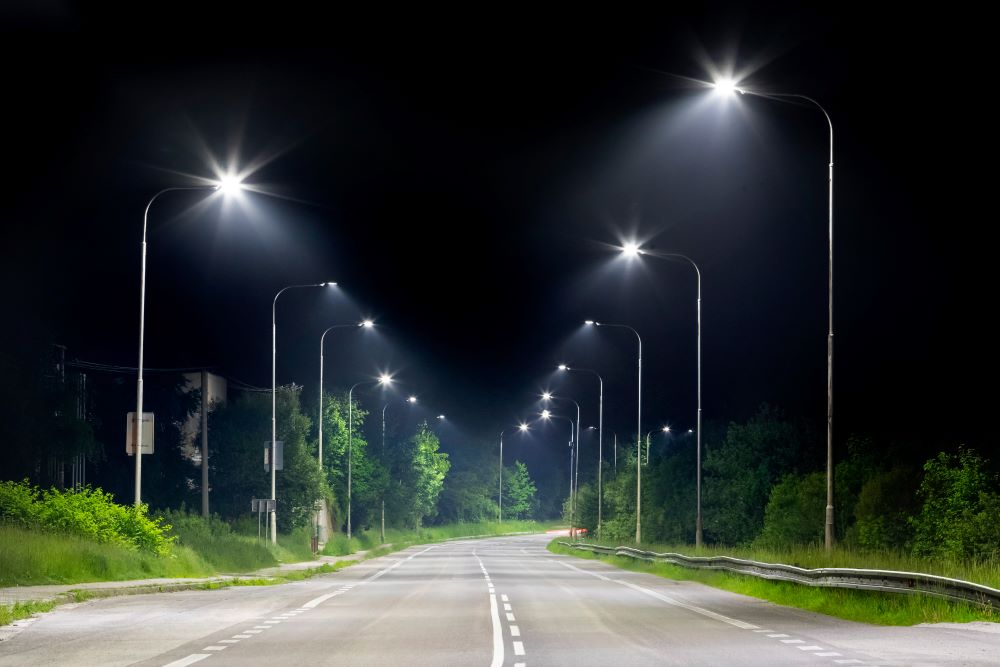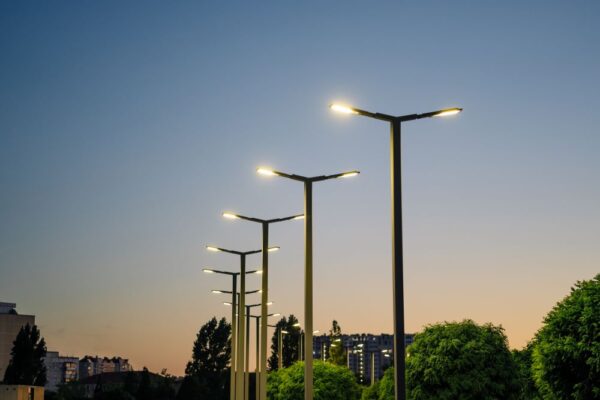Considerations of safe street lighting will beg the question, “safe for whom?” Creating safe street lighting for pedestrians will involve different factors than making streets safe for motorists. Businesses and street residents will have their own ideas of what constitutes safe street lighting, as will city managers who are charged with using taxpayer dollars to pay for safe street lighting.
Regardless of what factors are considered, municipalities around the world, including Los Angeles, Chicago, Calgary, Adelaide, and Copenhagen, have concluded that LED lighting has the most utility and versatility for all safe street lighting considerations. As with many transitions to new technologies, some of these cities have needed to make adjustments to reduce glare and excessive brightness from some early generations of LEDs, but LED manufacturers have responded to these concerns with even better street lighting that reduces sleep-preventing glare and that provides the safest conditions for everyone.
What to Consider for Safe Street Lighting
Street lighting plays a vital role in creating safer and more secure communities. Well-designed and properly maintained street lighting enhances visibility, deters crime, and ensures the safety of pedestrians, cyclists, and drivers. When considering street lighting installations or upgrades, it’s essential to take various factors into account to ensure the effectiveness and safety of the lighting system. In this article, we will explore the key considerations for safe street lighting.
Lighting Levels:
One of the primary considerations for safe street lighting is achieving appropriate lighting levels. The lighting should be sufficient to allow pedestrians and motorists to navigate the area safely. Lighting levels can be determined based on industry standards and guidelines, taking into account factors such as road classification, pedestrian traffic, and the presence of other infrastructure.
Uniformity and Distribution:
Uniformity of lighting ensures consistent visibility throughout the area, minimizing areas of darkness and potential safety hazards. Proper distribution of light across the street helps eliminate glare and shadows, enhancing overall visibility and reducing the risk of accidents.
Color Temperature:
Color temperature refers to the perceived color of light emitted by the street lighting. It is crucial to select the appropriate color temperature for street lighting to ensure optimal visibility and recognition of objects and people. Generally, a neutral white or cool white light is preferred, as it provides good color rendering and visibility without causing discomfort or excessive glare.
CRI (Color Rendering Index):
Color Rendering Index (CRI) measures the accuracy of how light sources reveal colors compared to natural light. It is essential to consider LED street lights with high CRI values to ensure accurate color perception. This is particularly important in areas where color identification is crucial, such as traffic signals or surveillance cameras.
Glare Control:
Glare from street lights can be a significant concern, as it can impair vision and create hazardous conditions for drivers and pedestrians. Street lighting fixtures should be properly designed and shielded to minimize glare and direct light toward the intended areas. This can be achieved through the use of baffles, shields, or directional optics that direct light downward and prevent light from dispersing into unwanted areas.
Maintenance and Regular Inspections:
Regular maintenance and inspections of street lighting systems are crucial to ensure their effectiveness and safety. Burned-out bulbs, damaged fixtures, or misaligned lights can compromise visibility and increase safety risks. Timely maintenance, such as replacing faulty components and cleaning light fixtures, helps maintain proper illumination levels and ensures a safe environment.
Energy Efficiency and Sustainability:
While safety is of paramount importance, it’s equally essential to consider energy efficiency and sustainability in street lighting. LED technology offers significant energy savings compared to traditional lighting systems. Upgrading to energy-efficient LED street lights not only reduces energy consumption but also lowers maintenance costs due to their longer lifespan and reduced need for frequent bulb replacements.
Smart Lighting Systems:
Advancements in technology have led to the development of smart lighting systems for street lighting. These systems incorporate features such as remote control, automated dimming, and motion sensors. Smart lighting can optimize energy usage, reduce light pollution, and enhance safety by adjusting lighting levels based on real-time conditions and traffic patterns.
Community Input and Feedback:
Engaging with the local community and considering their input and feedback regarding street lighting can be valuable. Community members may have insights into specific safety concerns or areas where lighting improvements are needed. Open communication channels and incorporating community feedback can help create a safer and more inclusive lighting environment.
The Importance of Safe Street Lighting
Safe street lighting is a critical component in creating secure and well-illuminated public spaces. When planning or upgrading street lighting systems, considering factors such as lighting levels, uniformity, color temperature, glare control, maintenance, energy efficiency, and community input ensures an effective and safe lighting solution. By prioritizing safety and adopting modern lighting
Pedestrians and residents will most likely want street lighting that provides consistent targeted lighting on footpaths with no shadows or unlit regions that might provide cover for more dangerous elements. Newer generation LEDs are available in a variety of beam spread patterns that can be combined to give uniform illumination without spilling excess lighting onto houses where residents might not want interference from bright lights outside of their homes. Reducing light pollution and glare may be secondary to other safety considerations, but they are equally important to individuals who will deal with those issues.
Motorists will want intersections and roadways to be sufficiently lit to help them to see oncoming traffic and road hazards. The consistent and uniform lighting that LEDs create will also help reduce eyesight fatigue among motorists. That fatigue is typical when drivers move through alternating light and dark zones that might be created with less uniform lighting systems. LED street lighting that has an optimum combination of lighting color temperature and color rendering index will also give drivers the best opportunity to see subtle color contrasts on surfaces and objects, thus further improving conditions for safe driving.
City planners are beginning to better appreciate how LED street lighting can reduce their operating budgets with better illumination that costs less and that has a lower carbon footprint than traditional street lighting. With greater savings on city utility bills, city can reallocate budgetary expenses to law enforcement and other areas of a city’s management that improve overall safety.
Those planners may also appreciate the superior lighting control capabilities that LEDs can give them. Newer LED street lighting systems can include motion sensors and other optical controllers that brighten or dim street lighting as a function of different levels of pedestrian or motorist traffic. With this technology, streets can be made safer without keeping street lights on at all times during evening hours. Internet-connected LED lights can also accumulate data on traffic volume, which could further enable city planners to allocate street lighting to places where they are most needed for optimum overall safety.
Achieving the safest street lighting in any urban environment will likely always be a work in progress. Advances in LED lighting technology are making great contributions toward that goal.








